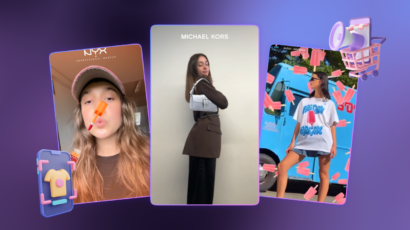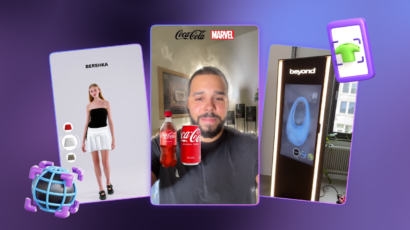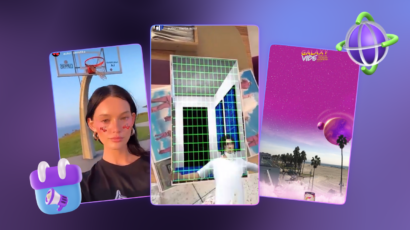In today’s world, where we’re all swimming in a sea of content, much of it spun out by AI without a human touch, it’s getting tougher for brands to truly connect with their audience. People now crave real, personalized solutions to their unique challenges – not just another piece of generic advice that seems like it was churned out by a machine.
Against this backdrop, Augmented Reality (AR) emerges as a breath of fresh air. It’s more than just a marketing tool; it’s a way to bring a human dimension back into the digital experience. AR invites customers into a space where they can interact with brands in a meaningful, engaging way, cutting through the noise of AI-generated content overload. This isn’t about flashy technology or the latest marketing buzzwords; it’s about creating genuine moments of connection that resonate on a personal level.
As we delve into the impact of AR on marketing, we’ll explore how it’s not just changing the game in terms of customer engagement but also offering a unique solution to the challenges posed by the abundance of impersonal, AI-generated content. AR stands out by providing immersive, personalized brand experiences that traditional advertising and AI can’t match, fostering a deeper sense of loyalty and driving sales in the process.
This conversation is an invitation to look beyond the jargon and exaggerated claims, to see how AR can help us reclaim a sense of authenticity and personal connection in the digital realm.
Understanding Today’s Customer Needs
Due to information overload and a need for individualized experiences, modern consumers are flooded with data from a variety of sources. Consumers now demand relevance and authenticity in their content; they are not thrilled with one-size-fits-all offerings. It is now essential for businesses to target specific pain spots if they want to draw in and hold the interest of their target audience
- Personalization: Consumers want experiences that are tailored to their interests and preferences.
- Relevance: Attention-grabbing generic content is no longer effective. Brands must deliver content that directly addresses customer pain areas.
- Authenticity: Customers value openness and authenticity in brand communications in this day of unlimited information
Customers frequently have issues with generic content and inconsistent brand experiences, which emphasizes the necessity for brands to modify and advance their marketing tactics. Businesses may establish deep connections with their target audience by being aware of and responsive to these needs.
AI Content Era and Immersive Marketing Option
In the era of AI-generated content, the landscape of digital marketing is undergoing a significant transformation. The inundation of AI-crafted content has necessitated a shift towards more immersive marketing strategies that blend the lines between reality and the digital realm.
Augmented Reality (AR) stands at the forefront of this shift, offering innovative opportunities for brands to engage with their audience in meaningful and memorable ways. By leveraging AR and other immersive technologies, businesses can craft experiences that not only capture the attention of their consumers but also build deeper levels of brand loyalty. This approach marks a departure from traditional digital advertising, moving towards interactions that are more engaging, personalized, and impactful.
According to Think Mobiles, 72% of AR users said they purchased stuff
they didn’t plan to buy, because of AR
User Engagement and Memorability
The strong connection between immersive content and increased user interaction is evident. Utilizing Augmented Reality (AR), there’s a significant opportunity to enhance brand recall and engage audiences in ways that were once unimaginable. This method not only improves the user experience but also ensures that brand encounters are impactful and memorable.
WYLD Male by getwyld.in introduces an AR experience where a simple card awakens into personalized interaction. Through augmented reality, what appears as just a card evolves into an live setting with elements designed for interaction. The feature where an animated character converses directly with the user brings a real-time engagement, making the interaction not just personalized but also memorable and shareable. This direct and customized interaction is designed to capture the user’s interest and leave a lasting impression.
The “Celebration Lens” by disneyd23 uses AR technology to create a simple yet engaging environment where users can experience the essence of a festive gathering. This digital experience is designed with the aim of bringing a smile to users’ faces, allowing for a quick diversion from daily routines into a space of light-hearted celebration. The main goal is straightforward: to share a sense of joy and provide a brief, enjoyable pause in the user’s day.
Grind The Essential” by fore.coffee introduces an AR feature that aims to enrich the customer’s experience with the brand’s offerings through a new, engaging way to explore coffee. This digital interaction is designed to deepen the customer’s connection with the brand, fostering loyalty and creating positive memories associated with their products. By offering a unique and straightforward way to experience their coffee, fore.coffee hopes to enhance customer satisfaction and reinforce a lasting, favorable impression of the brand.
Driving Sales Through Value-Driven Content
Incorporating Augmented Reality (AR) into marketing strategies significantly impacts sales and customer engagement, as demonstrated by recent studies. Research indicates that AR enhances product evaluation before purchase, leading to a positive impact on sales, especially for niche products and less popular brands. This technology is particularly beneficial for premium products, as it can increase overall revenues by improving decision comfort and reducing purchase hesitations. Moreover, AR has shown to promote online channel adoption and category expansion, especially among new customers, which is valuable for omni-channel retailers aiming to convert offline customers to online ones (source).
The growing AR market is expected to reach significant milestones by 2024, with mobile AR users projected to hit 1.73 billion. This expansive growth underscores AR’s appeal across various demographics, from students and professionals to gamers and shoppers, indicating its potential to reshape numerous industrie (source).
Furthermore, in the e-commerce sector, 64% of online shoppers believe AR will enhance their shopping experience, signaling a shift towards more interactive and immersive online shopping environments. This perception is backed by the substantial influence AR has on improving customer loyalty and experience, with a notable percentage of brands using AR reporting significant positive impacts (source).
These insights illustrate AR’s critical role in driving sales and fostering deeper customer engagement through innovative and immersive experiences. By reducing customer uncertainty and offering personalized interactions, AR not only meets but exceeds modern consumer expectations, paving the way for long-term business success.







